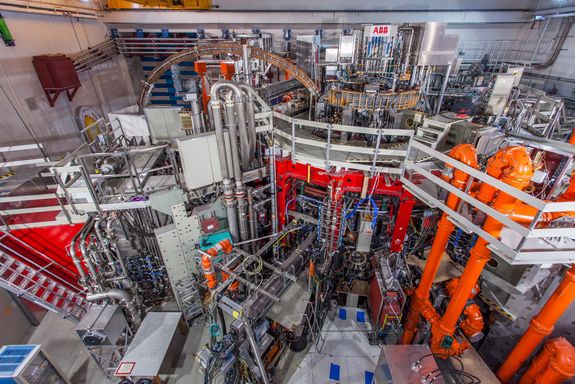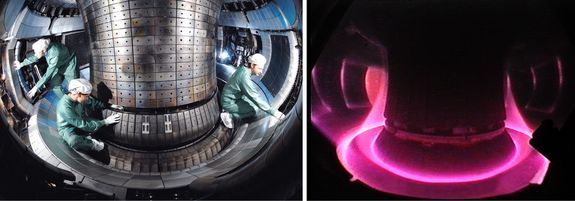Nuclear fusion power plants could one day provide a sustainable solution to our energy problems - but to date there is no commercial nuclear fusion reactor in operation. To realize fusion reactions, the plasma in the center must be very hot (about 100 million °C), and at the same time the wall of the reactor must not melt. The edge of the plasma must therefore be well insulated from the reactor wall. In this region, however, plasma instabilities called ELMs occur frequently. During such events, energetic particles from the plasma may hit the wall of the reactor, potentially damaging it. These instabilities are one of the most important obstacles on the way to a commercial reactor.
Now the fusion research team of TU Wien, opens an external URL in a new window together with the Max Planck Institute for Plasma Physics (IPP) in Garching, opens an external URL in a new window (Germany) could demonstrate: There is an operational regime for fusion reactors that avoids this problem. Instead of large potentially destructive instabilities, one intentionally accepts many small instabilities that do not pose a problem for the reactor’s walls. The results have now been published in the journal Physical Review Letters as Editors' Suggestion.
The renaissance of a disregarded mode of operation
In a toroidal tokamak fusion reactor, ultra-hot plasma particles move at high speeds. Powerful magnetic coils ensure that the particles remain confined instead of hitting the reactor wall with destructive force. "However, you don't want to isolate the plasma perfectly from the reactor wall either; after all, new fuel has to be added and the helium produced during fusion has to be removed," explains Friedrich Aumayr, Professor of Ion & Plasma Physics at the Institute of Applied Physics of TU Wien in Vienna, Austria.
The details of the dynamics inside the reactor are complicated: The motion of the particles depends on plasma density, temperature and magnetic field. Depending on how one chooses these parameters, different regimes of operation are possible. In a long-standing collaboration between Friedrich Aumayr's group at TU Wien and the IPP Garching group coordinated by Elisabeth Wolfrum (group leader at IPP Garching and TU Vienna professor), a novel operating regime has now been developed and shown to prevent the particularly destructive plasma instabilities called “Type-I ELMs”.
Experiments already showed a few years ago: If one slightly deforms the plasma through the magnetic coils, so that the plasma cross-section no longer looks elliptical, but rather resembles a rounded triangle, and if one simultaneously increases the density of the plasma especially at the edge, then the dangerous Type-I ELMs can be prevented.
"At first, however, this was thought to be a scenario that only occurs in currently running smaller machines such as ASDEX Upgrade (IPP Garching) and is irrelevant for a large reactor," explains Lidija Radovanovic, who is currently working on her PhD thesis on this topic at TU Wien. "However, with new experiments and simulations, we have now been able to show: The regime can prevent the dangerous instabilities even in parameter ranges foreseen for reactors like ITER."
Like a pot with a lid
Due to the triangular shape of the plasma cross-section and the controlled injection of additional particles at the plasma edge, many small instabilities occur - several thousand times per second. "These small particle bursts hit the wall of the reactor faster than it can heat up and cool down again," says Georg Harrer, lead author of the paper, who received a two-year EUROfusion Researcher Grant from the EU to further study the new operation regime. "Therefore, these individual instabilities do not play a major role for the reactor wall." But as the team has been able to show through detailed simulation calculations, these mini-instabilities prevent the large instabilities that would otherwise cause damage.
"It's a bit like a cooking pot with a lid, where the water starts to boil," Georg Harrer explains. "If pressure keeps building up, the lid will lift and rattle heavily due to the escaping steam. But if you tilt the lid slightly, then steam can continuously escape, and the lid remains stable and doesn't rattle."
This fusion reactor operation regime can be implemented in a variety of reactors - not only at the ASDEX Upgrade reactor in Garching, Germany, but also at ITER, opens an external URL in a new window, currently under construction in France, or even in future DEMO, opens an external URL in a new window fusion plants. "Our work represents a breakthrough in understanding the occurrence and prevention of large Type I ELMs," says Elisabeth Wolfrum. "The operation regime we propose is probably the most promising scenario for future fusion power plant plasmas."
The research described is part of the Austrian fusion research program and was carried out within the EU project EUROfusion, opens an external URL in a new window.
Origina lpublication
Contact
Dr. Georg Harrer
Institute of Applied Physics
TU Wien
+43 1 58801 13434
+43 664 4001145
harrer@iap.tuwien.ac.at
Prof. Friedrich Aumayr
Institute of Applied Physics
TU Wien
+43 1 58801 13430
+43 664 605883471
friedrich.aumayr@tuwien.ac.at



